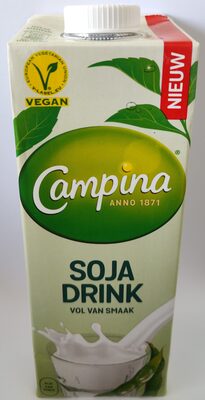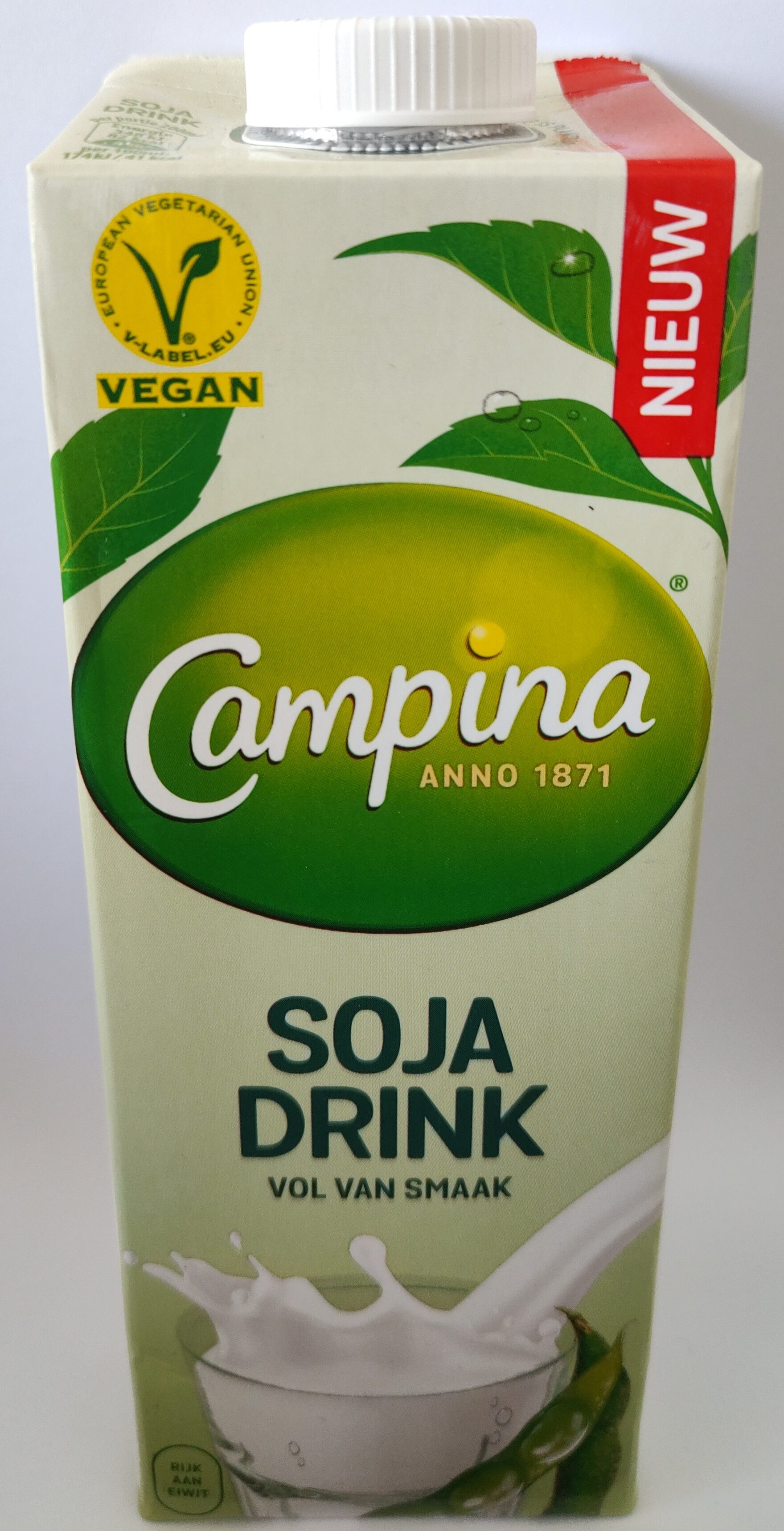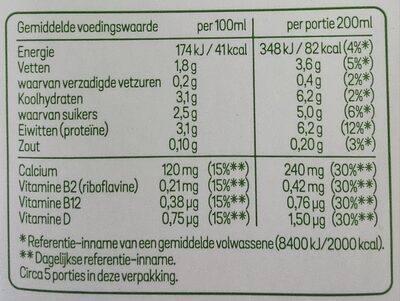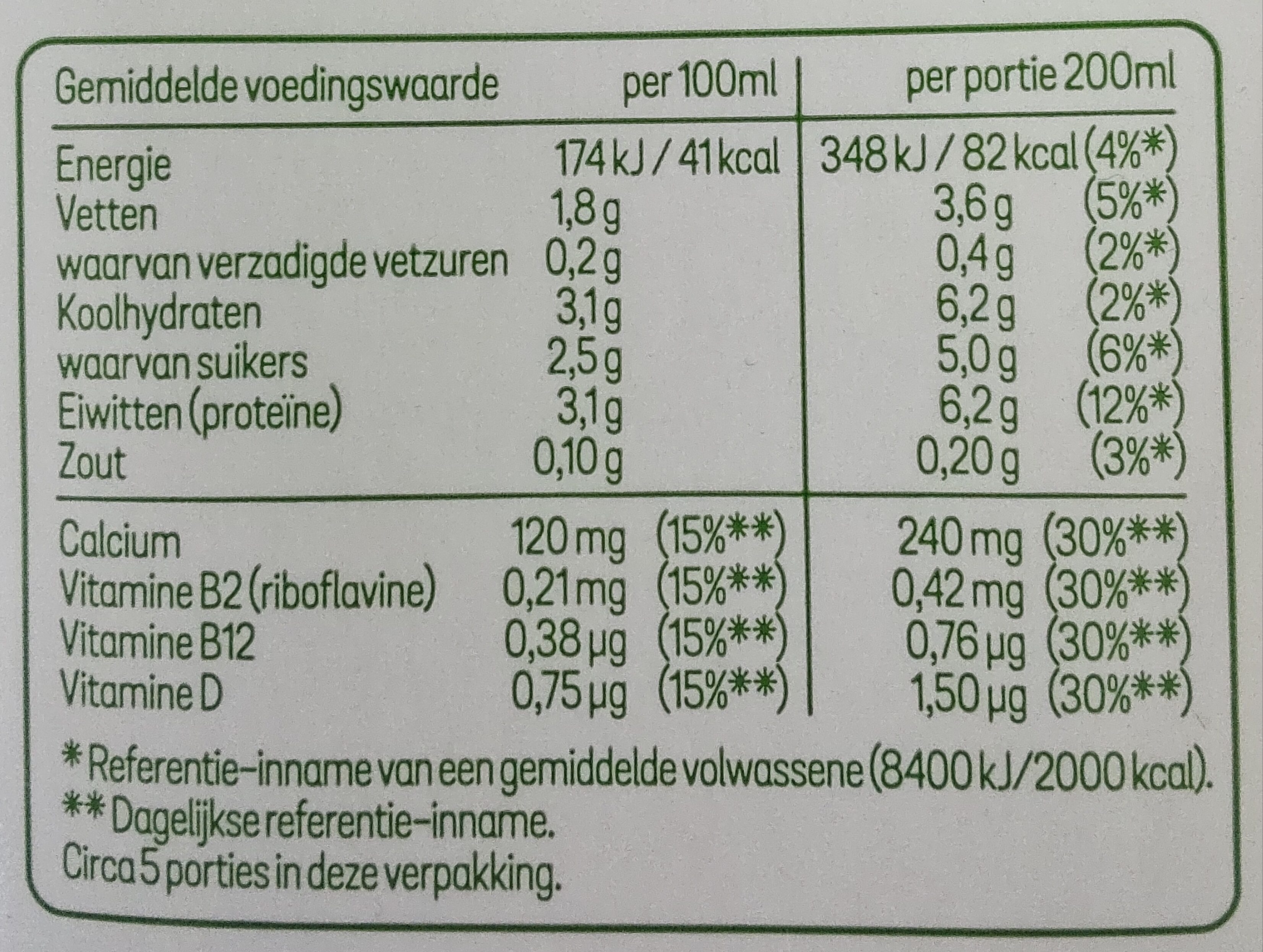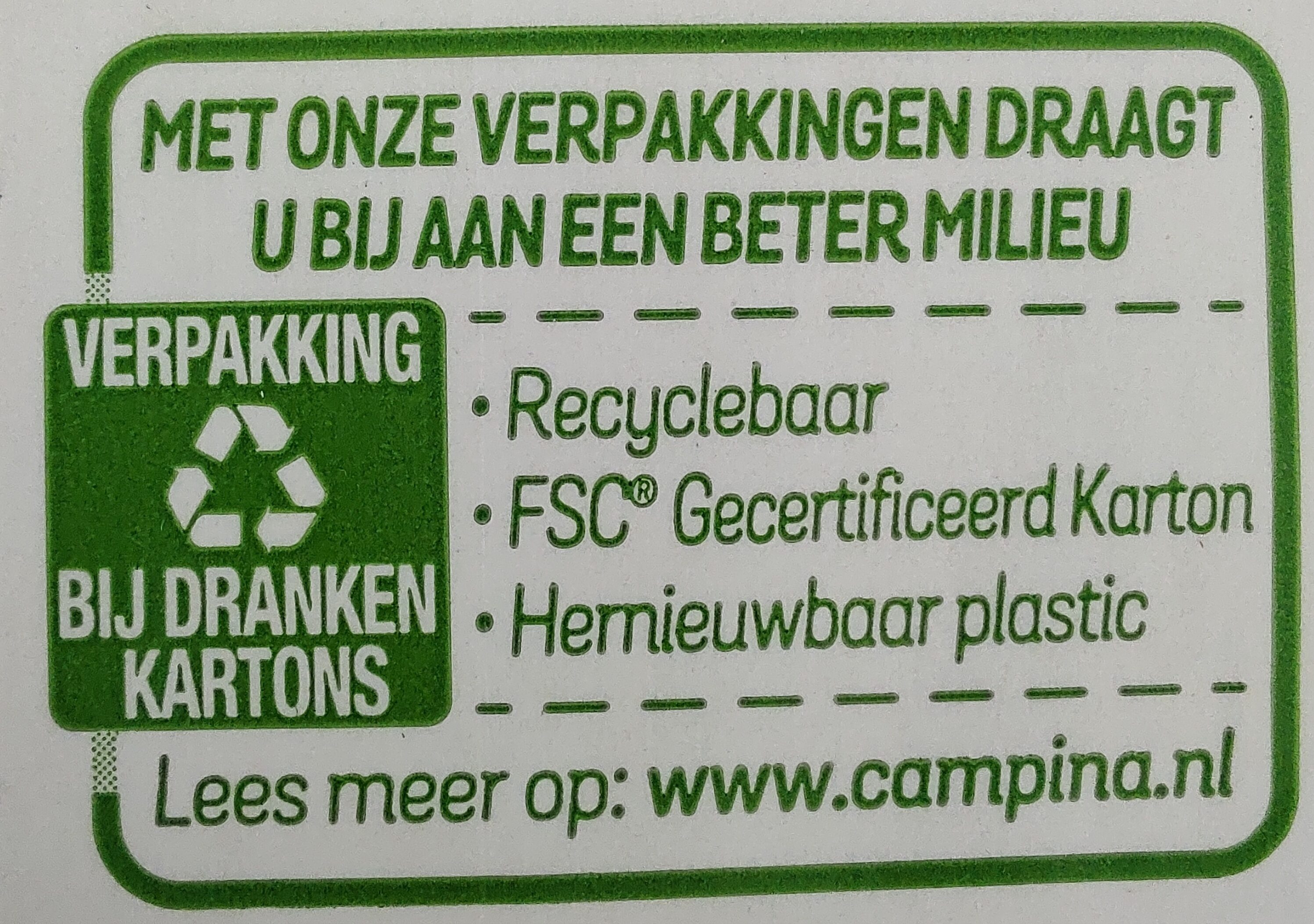Help us make food transparency the norm!
As a non-profit organization, we depend on your donations to continue informing consumers around the world about what they eat.
The food revolution starts with you!
Sojadrank - Campina - 1 liter
Sojadrank - Campina - 1 liter
Barcode: 8712800000983 (EAN / EAN-13)
Quantity: 1 liter
Packaging: Composite material, Tetra Pak, Tetra Brik Aseptic
Brands: Campina
Categories: Plant-based foods and beverages, Beverages, Plant-based foods, Legumes and their products, Dairy substitutes, Milk substitutes, Plant-based beverages, Plant-based milk alternatives, Legume-based drinks, Soy-based drinks
Labels, certifications, awards:
Vegetarian, Vegan, European Vegetarian Union, European Vegetarian Union Vegan, FSC, FSC Mix


Origin of ingredients: Europe
Countries where sold: Netherlands
Matching with your preferences
Health
Ingredients
-
13 ingredients
: Water, sojaboon 11%, suiker, calcium fosfaten, stabilisator: gellangom; zeezout, zuurteregelaar: monokaliumfosfaat, natuurlijk aroma, vitamine B2, B12 en D.Allergens: Soybeans, nl:sojaboonTraces: Gluten, Nuts
Food processing
-
Ultra processed foods
Elements that indicate the product is in the 4 - Ultra processed food and drink products group:
- Additive: E101 - Riboflavin
- Additive: E418 - Gellan gum
- Ingredient: Flavouring
Food products are classified into 4 groups according to their degree of processing:
- Unprocessed or minimally processed foods
- Processed culinary ingredients
- Processed foods
- Ultra processed foods
The determination of the group is based on the category of the product and on the ingredients it contains.
Additives
-
E101 - Riboflavin
Riboflavin: Riboflavin, also known as vitamin B2, is a vitamin found in food and used as a dietary supplement. Food sources include eggs, green vegetables, milk and other dairy product, meat, mushrooms, and almonds. Some countries require its addition to grains. As a supplement it is used to prevent and treat riboflavin deficiency and prevent migraines. It may be given by mouth or injection.It is nearly always well tolerated. Normal doses are safe during pregnancy. Riboflavin is in the vitamin B group. It is required by the body for cellular respiration.Riboflavin was discovered in 1920, isolated in 1933, and first made in 1935. It is on the World Health Organization's List of Essential Medicines, the most effective and safe medicines needed in a health system. Riboflavin is available as a generic medication and over the counter. In the United States a month of supplements costs less than 25 USD.Source: Wikipedia
-
E340 - Potassium phosphates
Potassium phosphate: Potassium phosphate is a generic term for the salts of potassium and phosphate ions including: Monopotassium phosphate -KH2PO4- -Molar mass approx: 136 g/mol- Dipotassium phosphate -K2HPO4- -Molar mass approx: 174 g/mol- Tripotassium phosphate -K3PO4- -Molar mass approx: 212.27 g/mol-As food additives, potassium phosphates have the E number E340.Source: Wikipedia
-
E340i - Monopotassium phosphate
Potassium phosphate: Potassium phosphate is a generic term for the salts of potassium and phosphate ions including: Monopotassium phosphate -KH2PO4- -Molar mass approx: 136 g/mol- Dipotassium phosphate -K2HPO4- -Molar mass approx: 174 g/mol- Tripotassium phosphate -K3PO4- -Molar mass approx: 212.27 g/mol-As food additives, potassium phosphates have the E number E340.Source: Wikipedia
-
E418 - Gellan gum
Gellan gum: Gellan gum is a water-soluble anionic polysaccharide produced by the bacterium Sphingomonas elodea -formerly Pseudomonas elodea based on the taxonomic classification at the time of its discovery-. Its taxonomic classification has been subsequently changed to Sphingomonas elodea based on current classification system. The gellan-producing bacterium was discovered and isolated by the former Kelco Division of Merck & Company, Inc. in 1978 from the lily plant tissue from a natural pond in Pennsylvania, USA. It was initially identified as a substitute gelling agent at significantly lower use level to replace agar in solid culture media for the growth of various microorganisms Its initial commercial product with the trademark as "GELRITE" gellan gum, was subsequently identified as a suitable agar substitute as gelling agent in various clinical bacteriological media.Source: Wikipedia
Ingredients analysis
-
Palm oil free
No ingredients containing palm oil detected
-
Vegan
No non-vegan ingredients
Unrecognized ingredients: Vitamin b12, Vitamin D
-
Vegetarian
No non-vegetarian ingredients detected
Unrecognized ingredients: Vitamin b12, Vitamin D
-
Details of the analysis of the ingredients
: Water, _sojaboon_ 11%, suiker, stabilisator (gellangom), zeezout, zuurteregelaar (monokaliumfosfaat), natuurlijk aroma, vitaminen, vitamine B2, vitamine B12, vitamine D- Water -> en:water - vegan: yes - vegetarian: yes - ciqual_food_code: 18066 - percent_min: 83.3 - percent_max: 89
- _sojaboon_ -> en:soya-bean - vegan: yes - vegetarian: yes - ciqual_food_code: 20901 - percent_min: 11 - percent: 11 - percent_max: 11
- suiker -> en:sugar - vegan: yes - vegetarian: yes - ciqual_proxy_food_code: 31016 - percent_min: 0 - percent_max: 2.5
- stabilisator -> en:stabiliser - percent_min: 0 - percent_max: 2.5
- gellangom -> en:e418 - vegan: yes - vegetarian: yes - percent_min: 0 - percent_max: 2.5
- zeezout -> en:sea-salt - vegan: yes - vegetarian: yes - ciqual_food_code: 11082 - percent_min: 0 - percent_max: 0.1
- zuurteregelaar -> en:acidity-regulator - percent_min: 0 - percent_max: 0.1
- monokaliumfosfaat -> en:e340i - vegan: yes - vegetarian: yes - percent_min: 0 - percent_max: 0.1
- natuurlijk aroma -> en:natural-flavouring - vegan: maybe - vegetarian: maybe - percent_min: 0 - percent_max: 0.1
- vitaminen -> en:vitamins - vegan: yes - vegetarian: yes - percent_min: 0 - percent_max: 0.1
- vitamine B2 -> en:e101 - vegan: maybe - vegetarian: yes - percent_min: 0 - percent_max: 0.1
- vitamine B12 -> en:vitamin-b12 - percent_min: 0 - percent_max: 0.1
- vitamine D -> en:vitamin-d - percent_min: 0 - percent_max: 0.1
Nutrition
-
Very good nutritional quality
⚠ ️Warning: the amount of fiber is not specified, their possible positive contribution to the grade could not be taken into account.⚠ ️Warning: the amount of fruits, vegetables and nuts is not specified on the label, it was estimated from the list of ingredients: 11This product is not considered a beverage for the calculation of the Nutri-Score.
Positive points: 1
- Proteins: 1 / 5 (value: 3.1, rounded value: 3.1)
- Fiber: 0 / 5 (value: 0, rounded value: 0)
- Fruits, vegetables, nuts, and colza/walnut/olive oils: 0 / 5 (value: 11, rounded value: 11)
Negative points: 0
- Energy: 0 / 10 (value: 174, rounded value: 174)
- Sugars: 0 / 10 (value: 2.5, rounded value: 2.5)
- Saturated fat: 0 / 10 (value: 0.2, rounded value: 0.2)
- Sodium: 0 / 10 (value: 40, rounded value: 40)
The points for proteins are counted because the negative points are less than 11.
Nutritional score: (0 - 1)
Nutri-Score:
-
Nutrient levels
-
Fat in moderate quantity (1.8%)
What you need to know- A high consumption of fat, especially saturated fats, can raise cholesterol, which increases the risk of heart diseases.
Recommendation: Limit the consumption of fat and saturated fat- Choose products with lower fat and saturated fat content.
-
Saturated fat in low quantity (0.2%)
What you need to know- A high consumption of fat, especially saturated fats, can raise cholesterol, which increases the risk of heart diseases.
Recommendation: Limit the consumption of fat and saturated fat- Choose products with lower fat and saturated fat content.
-
Sugars in moderate quantity (2.5%)
What you need to know- A high consumption of sugar can cause weight gain and tooth decay. It also augments the risk of type 2 diabetes and cardio-vascular diseases.
Recommendation: Limit the consumption of sugar and sugary drinks- Sugary drinks (such as sodas, fruit beverages, and fruit juices and nectars) should be limited as much as possible (no more than 1 glass a day).
- Choose products with lower sugar content and reduce the consumption of products with added sugars.
-
Salt in low quantity (0.1%)
What you need to know- A high consumption of salt (or sodium) can cause raised blood pressure, which can increase the risk of heart disease and stroke.
- Many people who have high blood pressure do not know it, as there are often no symptoms.
- Most people consume too much salt (on average 9 to 12 grams per day), around twice the recommended maximum level of intake.
Recommendation: Limit the consumption of salt and salted food- Reduce the quantity of salt used when cooking, and don't salt again at the table.
- Limit the consumption of salty snacks and choose products with lower salt content.
-
-
Nutrition facts
Nutrition facts As sold
for 100 g / 100 mlAs sold
per serving (200 ml)Compared to: Soy-based drinks Energy 174 kj
(41 kcal)348 kj
(82 kcal)-12% Fat 1.8 g 3.6 g -3% Saturated fat 0.2 g 0.4 g -40% Carbohydrates 3.1 g 6.2 g -26% Sugars 2.5 g 5 g -25% Fiber ? ? Proteins 3.1 g 6.2 g -0% Salt 0.1 g 0.2 g +4% Vitamin D 0.75 µg 1.5 µg -50% Vitamin B2 (Riboflavin) 0.21 mg 0.42 mg -1% Vitamin B12 (cobalamin) 0.38 µg 0.76 µg -76% Calcium 120 mg 240 mg +3% Fruits‚ vegetables‚ nuts and rapeseed‚ walnut and olive oils (estimate from ingredients list analysis) 11 % 11 %
Environment
-
Eco-Score A - Very low environmental impact
⚠ ️Select a country in order to include the full impact of transportation.The Eco-Score is an experimental score that summarizes the environmental impacts of food products.→ The Eco-Score was initially developped for France and it is being extended to other European countries. The Eco-Score formula is subject to change as it is regularly improved to make it more precise and better suited to each country.Life cycle analysis
-
Average impact of products of the same category: A (Score: 90/100)
Category: Soy drink, plain, prepacked
Category: Soy drink, plain, prepacked
- PEF environmental score: 0.04 (the lower the score, the lower the impact)
- including impact on climate change: 0.44 kg CO2 eq/kg of product
Stage Impact Agriculture
28.5 %Processing
14.6 %Packaging
22.9 %Transportation
24.2 %Distribution
9.8 %Consumption
0.0 %
Bonuses and maluses
-
Origins of ingredients with a high impact
Malus: -2
Environmental policy: -2
Transportation: 0
Origin of the product and/or its ingredients % of ingredients Impact Europe 100 %High
-
Packaging with a low impact
Malus: -4
Shape Material Recycling Impact 1 Brick Tetra Brik Aseptic Recycle with drink cartons Medium
Eco-Score for this product
-
Impact for this product: A (Score: 84/100)
Product: Sojadrank - Campina - 1 liter
Life cycle analysis score: 90
Sum of bonuses and maluses: -6
Final score: 84/100
-
Carbon footprint
-
Equal to driving 0.2 km in a petrol car
44 g CO² per 100g of product
The carbon emission figure comes from ADEME's Agribalyse database, for the category: Soy drink, plain, prepacked (Source: ADEME Agribalyse Database)
Stage Impact Agriculture
24.7 %Processing
20.2 %Packaging
23.0 %Transportation
28.7 %Distribution
3.4 %Consumption
0.0 %
Packaging
-
Packaging with a low impact
-
Packaging parts
1 x Brick (Tetra Brik Aseptic)
-
Packaging materials
Material % Packaging weight Packaging weight per 100 g of product
-
Transportation
-
Origins of ingredients
Origins of ingredients with a high impact
Origin of the product and/or its ingredients % of ingredients Impact Europe 100 %High
Report a problem
-
Incomplete or incorrect information?
Category, labels, ingredients, allergens, nutritional information, photos etc.
If the information does not match the information on the packaging, please complete or correct it. Open Food Facts is a collaborative database, and every contribution is useful for all.
